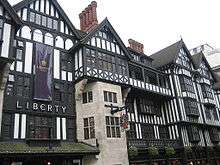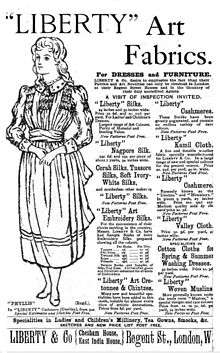Liberty (department store)
Liberty, commonly known as Liberty's, is a luxury department store in Great Marlborough Street, in the West End of London. Known around the world for its close connection to art and culture, it is most famous for its bold and floral print fabrics. The vast mock-Tudor store also sells men's, women's and children's fashion, beauty and homewares from a mix of high-end and emerging brands and labels.
 | |
| Private limited company | |
| Industry | Retail |
| Genre | Department store |
| Founded | 1875 |
| Founder | Arthur Lasenby Liberty |
| Headquarters | London, W1 United Kingdom |
| Products | Quality and luxury goods |
| Services | Offering innovative and eclectic designs to the public |
| Website | www |
The store is known to spot and champion young designers at the start of their careers, and many now-prominent brands were first available at Liberty. This continues Liberty's long reputation for working with British artists and designers.
History
_London_UK.jpg)
Early history
Arthur Lasenby Liberty was born in Chesham, Buckinghamshire, in 1843. He was employed by Messrs Farmer and Rogers in Regent Street in 1862, the year of the International Exhibition. By 1874, inspired by his 10 years of service, he decided to start a business of his own, which he did the next year.
With a £2,000 loan from his future father-in-law, he accepted the lease of half a shop at 218a Regent Street with three staff members.
The shop opened during 1875 selling ornaments, fabric and objets d'art from Japan and the East. Within eighteen months, he had repaid the loan and acquired the second half of 218 Regent Street. As the business grew, neighbouring properties were bought and added.[1]
In 1884, he introduced the costume department, directed by Edward William Godwin (1833–86), a distinguished architect and a founding member of The Costume Society. He and Arthur Liberty created in-house apparel to challenge the fashions of Paris.
In 1885, 142–144 Regent Street was acquired and housed the ever-increasing demand for carpets and furniture. The basement was named the Eastern Bazaar, and it was the vending place for what was described as "decorative furnishing objects". He named the property Chesham House, after the place in which he grew up. The store became the most fashionable place to shop in London, and Liberty fabrics were used for both clothing and furnishings. Some of its clientele were exotic, and included famous Pre-Raphaelite artists.

In November 1885, Liberty brought forty-two villagers from India to stage a living village of Indian artisans. Liberty's specialised in Oriental goods, in particular imported Indian silks, and the aim of the display was to generate both publicity and sales for the store.[2]
During the 1890s, Liberty built strong relationships with many English designers. Many of these designers, including Archibald Knox, practised the artistic styles known as Arts and Crafts and Art Nouveau, and Liberty helped develop Art Nouveau through his encouragement of such designers. The company became associated with this new style, to the extent that in Italy, Art Nouveau became known as the Stile Liberty, after the London shop.
1920s
The Tudor revival building was built so that trading could continue while renovations were being completed on the other premises, and in 1924, this store was constructed from the timbers of two ships: HMS Impregnable (formerly HMS Howe) and HMS Hindustan. The frontage on Great Marlborough Street is the same length as the Hindustan. It is a Grade II* listed building.
The emporium was designed by Edwin Thomas Hall and his son, Edwin Stanley Hall. They designed the building at the height of the 1920s fashion for Tudor revival. The shop was engineered around three light wells that formed the main focus of the building. Each of these wells was surrounded by smaller rooms to create a homely feel. Many of the rooms had fireplaces and some still exist.
The architectural historian Nikolaus Pevsner was very critical of the building's architecture, saying: "The scale is wrong, the symmetry is wrong. The proximity to a classical façade put up by the same firm at the same time is wrong, and the goings-on of a store behind such a façade (and below those twisted Tudor chimneys) are wrongest of all".[3]
Arthur Liberty died in 1917, seven years before the completion of his shops.
Post-war
Liberty, during the 1950s, continued its tradition for fashionable and eclectic design. All departments in the shop had a collection of both contemporary and traditional designs. New designers were promoted and often included those still representing the Liberty tradition for handcrafted work.
In 1955, Liberty began opening several regional stores in other UK cities; the first of these was in Manchester.[4] Subsequent shops opened in Bath, Brighton, Chester, York, Kingston upon Thames, Exeter and Norwich.
During the 1960s, extravagant and Eastern influences once again became fashionable, as well as the Art Deco style, and Liberty adapted its furnishing designs from its archive.
In 1996, Liberty announced the closure of its twenty shops outside London, and instead focused on smaller outlets at airports.[4]
Since 1988, Liberty has had a subsidiary in Japan which sells Liberty-branded products in major Japanese shops. It also sells Liberty fabrics to international and local fashion stores with bases in Japan.
2000s
Liberty's London store was sold for £41.5 million and then leased back by the firm in 2009, to pay off debts ahead of a sale.[5] Subsequently, in 2010, Liberty was taken over by private equity firm BlueGem Capital in a deal worth £32 million.[6]
Turnover for 2018 was forecast to be £133m[7] with much of its growth coming from its own brand collections of fabrics, homeware, accessories and ready-to-wear fashion.
TV documentary
From 2 December 2013, Liberty was the focus of a three-part hour-long episode TV documentary series titled Liberty of London, airing on Channel 4.[8][9] The documentary follows Ed Burstell (Managing Director) and the department's retail team in the busy lead up to Christmas 2013.[8]
Channel 4 further commissioned a second series of the documentary on 28 October 2014. This series featured four, one hour-long episodes based on six months worth of unprecedented footage. Series two commenced on 12 November 2014.[10]
Collaborations
Liberty has a history of collaborative projects – from William Morris and Dante Gabriel Rossetti in the nineteenth century to Yves Saint Laurent and Dame Vivienne Westwood in the twentieth. Recent collaborations include brands such as Scott Henshall, Nike, Dr. Martens, Hello Kitty, Barbour, House of Hackney, Vans, Onia, Manolo Blahnik, Uniqlo, Superga, T. M. Lewin, Drew Pritchard of Salvage Hunters and antique lighting specialist Fritz Fryer.
See also
- Althea McNish - a textile designer commissioned by Liberty's to design fashion and furnishing textiles and scarves from 1957
- List of department stores by country
- List of department stores of the United Kingdom
- Merton Abbey Mills - a textile factory in Merton, London, which was used extensively for printing Liberty fabrics.
- Retail
References and sources
- References
- Iarocci, L., Visual Merchandising: The Image of Selling, Ashgate Publishing, 2013, pp 120-128
- "Gossamer | Made in England". Gossamer. Retrieved 17 June 2020.
- Bridget Cherry and Nikolaus Pevsner (1973). The Buildings of England – London 1: The Cities of London and Westminster (third edition). London: Penguin Books. p. 579. ISBN 0 14 0710 12 4.
- Blanchard, Tamsin (13 June 1996). "Has Liberty finally lost the thread?". The Independent. Retrieved 30 May 2013.
- Fletcher, Nick (15 March 2010). "Retailer Liberty agrees sale of flagship store for £41.5m". The Guardian. Retrieved 30 May 2013.
- Kollewe, Julia (28 June 2010). "Liberty's new owner sets out plans for growth". The Guardian. Retrieved 30 May 2013.
- https://www.theguardian.com/business/2019/feb/12/liberty-london-department-store-sale
- Jones, Nina (20 December 2013). "'Liberty of London' a Hit in the U.K." WWD. Retrieved 20 December 2013.
- "Liberty of London". Channel 4. 2 December 2013. Retrieved 9 December 2013.
- "Liberty of London – Series 2". Channel 4. 28 October 2014. Retrieved 6 November 2014.
- Sources
Alison Adburgham, Liberty's – A biography of a shop, George Allen and Unwin (1975)
External links
| Wikimedia Commons has media related to Liberty (department store). |